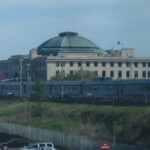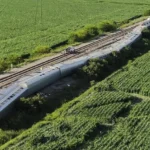Photo Recap – Crossing the Great Nullarbor Plain
The Nullarbor Plain has to be one of the great deserts of the world. But its name is misleading. Nullarbor comes from the Latin meaning “no trees,” and while that may be an accurate description in some parts of this magnificent wasteland, it’s a misnomer in many other areas.
At first glance, these photos will probably look the same, but on closer examination, just like the Nullarbor itself, you’ll see differences … in topography, in the vegetation, in the colors.
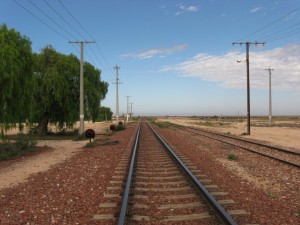 After a 30-minute stop at Cook, the Indian Pacific resumes it’s journey due west across the vast, desolate center of the Australian continent. Somewhere up ahead is the longest stretch of perfectly straight railroad track in the world – 324 miles. (It’s gonna look pretty much like this!)
After a 30-minute stop at Cook, the Indian Pacific resumes it’s journey due west across the vast, desolate center of the Australian continent. Somewhere up ahead is the longest stretch of perfectly straight railroad track in the world – 324 miles. (It’s gonna look pretty much like this!)
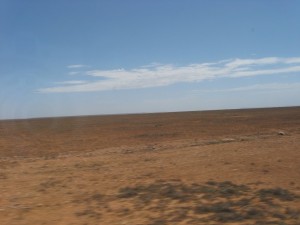 For the next hour or so, it’s table-top flat, dry as a bone and, wherever you look, not a tree in sight … just what I expected from the stories I’d heard of the Nullarbor “no trees” Plain.
For the next hour or so, it’s table-top flat, dry as a bone and, wherever you look, not a tree in sight … just what I expected from the stories I’d heard of the Nullarbor “no trees” Plain.
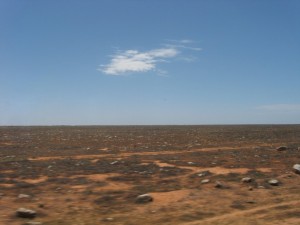 But, another 40 minutes farther on, I notice the rocks … some as large as oil drums … scattered to the horizon and beyond. There are no mountains for hundreds of miles. How did they get here? And how long have they been here?
But, another 40 minutes farther on, I notice the rocks … some as large as oil drums … scattered to the horizon and beyond. There are no mountains for hundreds of miles. How did they get here? And how long have they been here?
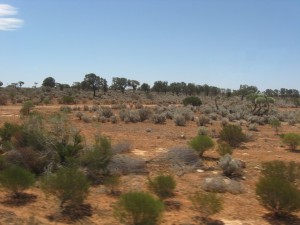 It’s close to noon now and hot out there! The rail cars are air conditioned and comfortable, but I stepped into the little toilet/shower off my compartment a bit ago and it must have been 100 degrees from the hot air that was blasting up from the tracks through the 2-inch drain in the floor. But despite the searing heat outside, there is now vegetation in the desert: gray-green brush related to sage and small gnarled trees.
It’s close to noon now and hot out there! The rail cars are air conditioned and comfortable, but I stepped into the little toilet/shower off my compartment a bit ago and it must have been 100 degrees from the hot air that was blasting up from the tracks through the 2-inch drain in the floor. But despite the searing heat outside, there is now vegetation in the desert: gray-green brush related to sage and small gnarled trees.
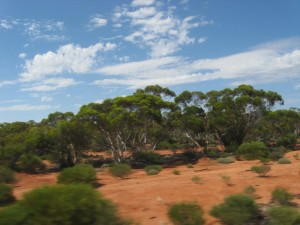 I’m happily distracted for a half-hour or so by a cold beer and some interesting conversation in the lounge car, but when I return my attention to the Nullarbor, it’s changed again – there’s red earth now, and sturdy full-sized trees with brilliant green leaves. Yet, for all intents and purposes, it’s just as hot and just as dry as ever.
I’m happily distracted for a half-hour or so by a cold beer and some interesting conversation in the lounge car, but when I return my attention to the Nullarbor, it’s changed again – there’s red earth now, and sturdy full-sized trees with brilliant green leaves. Yet, for all intents and purposes, it’s just as hot and just as dry as ever.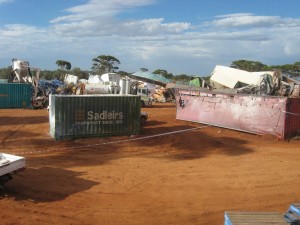 Now it’s our turn, and at a cautious 5 or 6 miles-per-hour, the Indian Pacific skirts what remains of the wreckage. The massive locomotives are still lying on their sides but, working with heavy equipment, crews have salvaged whatever they could, broken the wrecked rail cars into pieces and shoved the whole mess into a huge contorted pile of debris. Five minutes later, the Indian Pacific has resumed normal track speed and is heading directly into the setting sun. We’re due into the mining town of Kalgoorlie at just about dusk.
Now it’s our turn, and at a cautious 5 or 6 miles-per-hour, the Indian Pacific skirts what remains of the wreckage. The massive locomotives are still lying on their sides but, working with heavy equipment, crews have salvaged whatever they could, broken the wrecked rail cars into pieces and shoved the whole mess into a huge contorted pile of debris. Five minutes later, the Indian Pacific has resumed normal track speed and is heading directly into the setting sun. We’re due into the mining town of Kalgoorlie at just about dusk.
